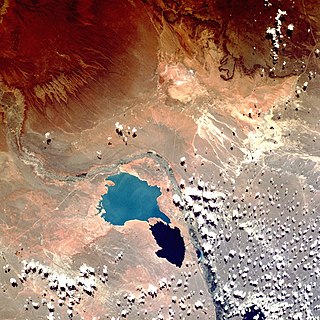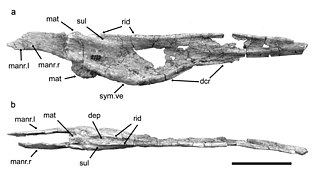
The Neuquén Group is a group of geologic formations found in Argentina. Rocks in the Neuquén Group fall within the Cenomanian to early Campanian stages of the Late Cretaceous Period. It overlies the older Lohan Cura Formation and is itself overlain by the younger Allen Formation of the Malargüe Group, separated from both by unconformities, dated to 98 and 79 Ma respectively.

Futalognkosaurus is a genus of titanosaurian dinosaur. The herbivorous Futalognkosaurus lived approximately 87 million years ago in the Portezuelo Formation, in what is now Argentina, of the Coniacian stage of the late Cretaceous Period. The fish and fossilized leaf debris on the site, together with other dinosaur remains, suggest a warm tropical climate in Patagonia during this period.
The Portezuelo Formation is a geologic formation of Late Cretaceous age, outcropping in the Mendoza, Río Negro and Neuquén provinces of Argentina. It is the fourth-oldest formation in the Neuquén Group and the older of the two formations in the Río Neuquén Subgroup. Formerly, that subgroup was treated as a formation, and the Portezuelo Formation was known as the Portezuelo Member.
The Bajo de la Carpa Formation is a geologic formation of the Neuquén Basin that crops out in northern Patagonia, in the provinces of Río Negro and Neuquén, Argentina. It is the oldest of two formations belonging to the Río Colorado Subgroup within the Neuquén Group. Formerly, that subgroup was treated as a formation, and the Bajo de la Carpa Formation was known as the Bajo de la Carpa Member.

Macrogryphosaurus is a genus of elasmarian dinosaur from the Coniacian age Upper Cretaceous Sierra Barrosa Formation of Argentina in Patagonia. It was described by Jorge Calvo and colleagues in 2007, with M. gondwanicus as the type and only species.

Peirosauridae is a Gondwanan family of mesoeucrocodylians that lived during the Cretaceous period. It was a clade of terrestrial crocodyliforms that evolved a rather dog-like skull, and were terrestrial carnivores. It was phylogenetically defined in 2004 as the most recent common ancestor of Peirosaurus and Lomasuchinae and all of its descendants. Lomasuchinae is a subfamily of peirosaurids that includes the genus Lomasuchus.
Pehuenchesuchus is an extinct genus of sebecosuchian mesoeucrocodylian. It was discovered in rocks of the late Turonian-Coniacian-age Upper Cretaceous Río Neuquén Formation (Neuquén Group, near Rincón de los Sauces, Neuquén, Argentina.
Lomasuchus is an extinct genus of peirosaurid notosuchian known from the Late Cretaceous of Neuquén Province, western central Argentina. It contains a single species, Lomasuchus palpebrosus.

Neuquén Basin is a sedimentary basin covering most of Neuquén Province in Argentina. The basin originated in the Jurassic and developed through alternating continental and marine conditions well into the Tertiary. The basin bounds to the west with the Andean Volcanic Belt, to the southeast with the North Patagonian Massif and to the northeast with the San Rafael Block and to the east with the Sierra Pintada System. The basin covers an area of approximately 120,000 square kilometres (46,000 sq mi). One age of the SALMA classification, the Colloncuran, is defined in the basin, based on the Collón Curá Formation, named after the Collón Curá River, a tributary of the Limay River.
Leufuichthys is an extinct genus of clupeomorph fish which existed in Patagonia, Argentina during the late Cretaceous epoch. It is known from the holotype – MUCPv 371, an incomplete specimen missing most of the cephalic skeleton and from the paratypes – MUCPv 344 incomplete specimen lacking head; MUCPv 346, incomplete specimen lacking most of skull; MUCPv 347, specimen bearing scales; MUCPv 348, incomplete specimen with skull and part of trunk. Leufuichthys was recovered from the Portezuelo Formation of the Rio Neuquén Subgroup. It was first named by Valéria Gallo, Jorge O. Calvo and Alexander W.A. Kellner in 2011 and the type species is Leufuichthys minimus.

Petrobrasaurus is a genus of herbivorous sauropod dinosaur. It is a titanosaur which lived during the upper Cretaceous period in what is now Rincón de los Sauces, Patagonia, Argentina. It is known from the holotype MAU-Pv-PH-449 — a partial disarticulated skeleton recovered from the Plottier Formation, Argentina. This genus was named by Leonardo S. Filippi, José Ignacio Canudo, Leonardo J. Salgado, Alberto C. Garrido, Rodolfo A. Garcia, Ignacio A. Cerda and Alejandro Otero in 2011, and the type species is Petrobrasaurus puestohernandezi. The generic name is derived from "Petrobras" and saurus, "lizard". The specific name refers to the Puesto Hernández oil field, where the fossil remains were found.

Pamparaptor is an extinct genus of maniraptoran theropod dinosaur from the Late Cretaceous Portezuelo Formation of the Neuquén province in Argentine Patagonia. Its precise classification is uncertain, but it is definitely a member of Paraves and probably a deinonychosaur. The authors who described it have argued that it is a dromaeosaurid. The genus contains a single species, P. micros, which is known from a single specimen consisting of a mostly complete and fully-articulated left foot, which preserves the iconic dromaeosaur-like “killing claw”.
Gasparinisuchus is an extinct genus of peirosaurid notosuchian known from the Late Cretaceous of Neuquén and Mendoza Provinces, western central Argentina. It contains a single species, Gasparinisuchus peirosauroides.

Overosaurus is an extinct genus of sauropod dinosaurs, containing only a single species, Overosaurus paradasorum. This species lived approximately 86 to 84 million years ago during the latter part of the Cretaceous Period in what is now Patagonia. Overosaurus paradasorum was relatively small compared to other sauropods from Patagonia, like the saltasaurids and other aeolosaurines, estimated as approximately 10 m (33 ft). It was a ground-dwelling herbivore.
Bayomesasuchus is an extinct genus of peirosaurid mesoeucrocodylian known from the early Late Cretaceous Cerro Lisandro Formation of Neuquén Province, western central Argentina. It contains a single species, Bayomesasuchus hernandezi. Even though it is known from relatively fragmentary remains, it represents one of the most basal peirosaurids.

Argentinadraco is an extinct genus of azhdarchoid pterosaur from the Late Cretaceous Portezuelo Formation of Argentina. It contains a single species, A. barrealensis, named in 2017 by Alexander Kellner and Jorge Calvo. Argentinadraco is unusual for bearing a bottom jaw with a concave bottom edge, as well as a pair of ridges and depressions on the top surface. These features distinguish it from all other azhdarchoid groups, complicating its assignment, but it may belong to the Chaoyangopteridae. The ridges on the lower jaw may have been used to feed on small invertebrates in loose sediment within the system of lakes and rivers that it resided in.
Kinesuchus is an extinct genus of crocodyliform peirosaurid from the Late Cretaceous Bajo de la Carpa Formation of Argentina. The type species, K. overoi, was described in 2018 from the holotype MAU-Pv-CO-583, a partial mandible.
Kaikaifilusaurus is an extinct genus of rhynchocephalians in the family Sphenodontidae from the Late Cretaceous of South America. Fossils of the genus were found in Cenomanian sediments of the Candeleros Formation and Turonian layers of the Huincul Formation, both of the Neuquén Basin and the Albian strata of the Cerro Barcino Formation in the Cañadón Asfalto Basin, all in Patagonia, Argentina. The genus contains two species, K. minimus and the type species K. calvoi.

Overoraptor is an extinct genus of paravian theropod of uncertain affinities from the Late Cretaceous Huincul Formation of Argentinian Patagonia. The genus contains a single species, O. chimentoi, known from several bones of the hands, feet, and hips alongside some vertebrae.
The Sierra Barrosa Formation is a geologic formation of the Neuquén Basin in the northern Patagonian provinces of Mendoza and Neuquén. The formation dates to the Late Cretaceous, middle to late Coniacian, and belongs to the Río Neuquén Subgroup of the Neuquén Group. The formation overlies the Los Bastos Formation and is overlain by the Plottier Formation. As the underlying Los Bastos Formation, the Sierra Barrosa Formation comprises mudstones and sandstones deposited in a fluvial environment.










